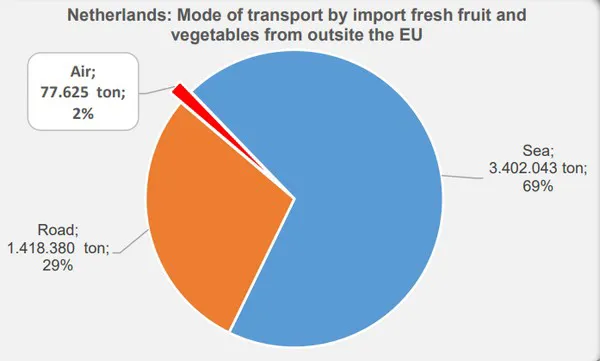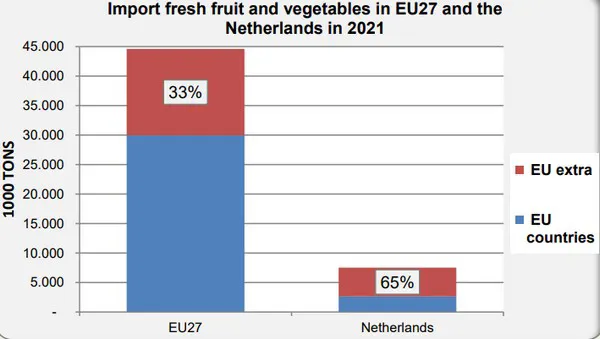In 2021, the European Union countries imported a combined 14.6 million tons of fruit and vegetable from outside the Union. More than 10.2 million tons entered the region by sea and 4.2 million tons over land. Only 275.000 tons - a mere two percent - were flown in.
The Netherlands is most of this produce's first stop. In 2021, this country imported about five million tons of fruits and vegetables from outside the EU. That was a third of all European Union imports from non-EU countries. The Netherlands shipped in 3.4 million tons of that and imported another 1.4 million tons by road. Last year, 77,600 tons, or two percent, of fruit and vegetables entered the Netherlands via air freight.

In the Netherlands, two-thirds from outside the EU
Based on Eurostat figures, all EU countries, together, imported 44.5 million tons of fresh vegetables in 2021. Eurostat bases imports on the last country the goods came from (registered by customs). So, Eurostat counts, say, South African fruit - of which a lot comes through the Netherlands and then goes to countries like Germany - as German imports from the Netherlands.
Based on this definition, trade in fresh fruits and vegetables from outside the EU had a 33% share. Re-exporting, or double counting, however, skews this picture. For the Netherlands individually, imports from outside the EU do say something. In 2021, 65% of all fresh fruits and vegetables imported by the Netherlands came from outside the EU.
Most from Brazil, much via Portugal
Within the EU, the Netherlands is also the country that gets the most fruit and vegetables flown in. With 53,100 tons, France is in second position. Spain, with 41,500 tons; Belgium, with 35,600 tons; Germany, with 32,700; and Portugal, with 18,800 tons, follow. Of all the fruits and vegetables that entered the EU by air in 2021, most - over 50,000 tons - came from Brazil.
Notable here was the 17,800 tons that arrived in Portugal. That involved 10,000 tons of papayas and 7,000 tons of mangoes. A lot of fruit and vegetables entered the EU by air from countries like Peru (32,000 tons), Mexico (28,000 tons), Kenya (27,000 tons), and Egypt (18,000 tons). South Africa and Ghana both sent more than 9,000 tons.

Mainly mangoes and papayas
Regarding 2021's total non-EU imports, mangoes and papayas are the top products with, respectively, 42.000 and 36.000 tons. Beans (27,000 tons), asparagus (24,000 tons), and pineapples (22,000 tons) follow. Brazil sent the most mangoes and papayas. Peru sent quite a lot of mangoes too, but the main product that arrived in the EU by air from that country was asparagus - 16,000 tons.
Mainly avocados were flown in from Mexico to the EU. That country also sent asparagus and mangoes. From Kenya, half the imports by air were beans, the other half snow peas/sugar snaps.
The Netherlands got most airfreight from Kenya
Last year, the Netherlands, thus, received 77,000 tons of fresh fruit and vegetables via airfreight. Most - 11,400 tons - came from Kenya. Peru (10,800 tons, Brazil (10,000 tons), Mexico (7,800 tons), South Africa (7,600 tons), and Egypt (5,700 tons) are next in line. From Kenya, as mentioned, it was beans (5,000 tons) and snow peas/sugar snaps (2,700 tons), and from Peru, mangoes (5,000 tons) and asparagus (4,700 tons).
Dutch imports by air from Brazil consisted mainly of papayas (5,800 tons) and mangoes (2,200 tons). From Mexico came avocados (3,200 tons) and asparagus (3,000 tons). According to Eurostat, air imports from South Africa mostly comprised watermelons and melons, and from Egypt, it was primarily beans.
Click here for the background figures.
For more information:
Jan Kees Boon
Fruit and Vegetable Facts
Website: www.fruitandvegetablefacts.com
Email: [email protected]
